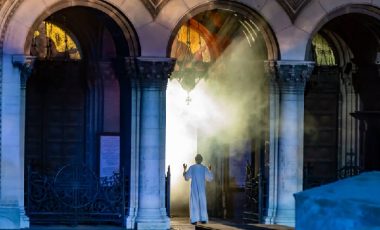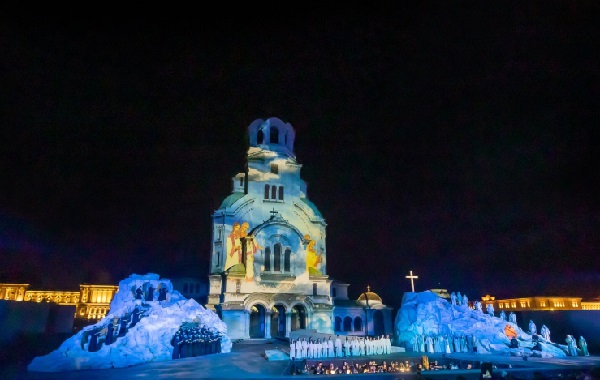 Bulgaria Fr Kiril Popov, The Hermit of Rila: Soloists, Children’s Vocal and Theatre Formation (Dimitar Kostantsaliev, director), Chorus and Orchestra of Sofia Opera / Metropolitan of Stara Zagora Kyprian (conductor). Patriarchal Cathedral of Saint Alexander Nevsky, Sofia, 26.7.2024. (GT)
Bulgaria Fr Kiril Popov, The Hermit of Rila: Soloists, Children’s Vocal and Theatre Formation (Dimitar Kostantsaliev, director), Chorus and Orchestra of Sofia Opera / Metropolitan of Stara Zagora Kyprian (conductor). Patriarchal Cathedral of Saint Alexander Nevsky, Sofia, 26.7.2024. (GT)

The origins of this production lie in the discovery by Archpriest Kiril Popov of ‘The Hermit of Rila’ in the church archives and his suggestion as a musical poem to Plamen Kartaloff of Sofia Opera, who immediately asked him to write the music for it. The orchestration by the Bulgarian composer and conductor Georgi Strezov includes Popov’s church hymns, as Popov writes: ‘In the Orthodox Church, we have a cappella performance of the chants during the service. However, when we are outside the temple, as in this case, the poem can be enhanced in music by the support of an orchestra. It was the very design of the author, Tihomir Pavlov: a libretto for a musical poem.’ This performance commemorates the consecration of the Saint Alexander Nevsky Patriarchal Cathedral one hundred years ago in Sofia.
The events of the sacred musical poem take place at the end of the ninth and the first half of the tenth century in the central Sredets region of the then Bulgarian kingdom. This was the golden age of Bulgaria, during the reigns of St Boris-Michael, Simeon the Great and St Peter. The musical story of John of Rila and his rejection of society and his casting out as a hermit summons up parallels with the passions of Christ written in the Middle Ages, most notably from the Oberammergau Passion Plays (performed every ten years), continued by such composers as Obrecht, Bach, Byrd, Guerrero, Victoria to Penderecki, and Pärt. Rather than based on Christ, the text by Tihomir Pavlov (1880 -1937) is taken from the life of Saint John the wonderworker from Rila (876-946) when Bulgaria was founded both as a state and independent church. Father Popov’s music reflects different musical styles hinting at Bulgarian and Russian Slavic sacred liturgies, especially Rachmaninov, Grechaninov, Tchaikovsky and Taneyev in a beautifully orchestrated fabric of sound which mixed superbly with the startling visual pictures projected onto the cathedral of Saint Alexander Nevsky.
The narrative of St John of Rila invokes the struggle between good and evil, and in which Pavlov’s sacred poem offered us sanctuary for almost two hours. An important connotation in this work is from the annals of the once great Kingdom of Bulgaria, invaded by foreign aggressors, most notably by Genghis Khan and his hordes, the Turkish khanates, the Hapsburg Empire and Nazi Germany. Today’s Bulgaria enjoys an independence in which the country and its people can celebrate its sovereignty – and there is a connection in Pavlov’s texts with Richard Wagner’s Ring, where we see the repeated cycle of humankind enduring suffering and redemption.

Kartaloff’s sets comprised two massive rock formations in front of the Cathedral – linked by a pathway that created an immense structure in front of the orchestra pit. Another innovation was a path between the audience and the stage for the procession on horseback of the Tsar Petar and his entourage. Each rock formation has several caves on the right; the summit bears a cross high above John’s hermit cave. The performance opened with the chiming of the Cathedral bells – creating a distinctively beautiful beginning. The narrative follows the life of the priest John from his youth to his casting out of society, and he takes refuge in a cave alone visited only by his followers.
There appear scenes of violence where devilish figures kill St John’s followers, and there is the appearance of the young Luka – the son of John’s brother who opposes John. In his brief appearance, we hear exquisite singing of Luka – a boy soprano, before he is killed by a snake on the mountain.
Act II finds John as an old man alone in his mountain refuge – yet Tsar Petar arrives in a spectacular scene with his entourage of seven horses. In an intensely gripping scene, the Tsar rises to the summit of the mountain where gifts of gold are offered to John, yet he refuses – he is not to be bought off, and the hermit sings that virtue is more valued than wealth. The monks sing of their faith in John, yet finally the old man in a remarkable scene crosses the pathway and enters the great gates of the cathedral from which misty clouds emerge as St John enters into heaven.
The musical performance was enhanced by outstanding singing of both soloists and choral; one had the impression that we were in the theatre, so natural was the acoustic picture created by the technicians. Of the singers, the most impressive was the noble baritone of Atanas Mladenov as the young John; who already impressed me in last year’s Parsifal as Amfortas, and as Gunther on the final day of the Ring; he has a beautifully rich voice and a stage presence to match. John’s brother Veselin Mihaylov was another stand out with his gorgeous baritone verifying his promise from his excellent Wotan in last month’s Das Rheingold. Despite his limited time on the stage, he is a singer of great potential. One of Mihaylov’s predecessors as a Wotan in Sofia – Nikolay Petrov as the Father Auxentius was masterly in his aged yet magnificent baritone in an excellent portrayal. The Tsar Petar of Angel Hristov was superb in his darkly hued bass and commanding stage presence. The Orchestra of Sofia Opera were outstanding under the direction of the Metropolitan of Stara Zagora Kyprian demonstrating vibrant harmonies from the woodwind groups and the percussion, and the rich verdant strings. Most memorable of all were the heavenly choruses of the children together with the men’s and women’s choruses.
A great asset to the drama on stage were the projections by Vladimir Grancharov and his Elektrick.me team of technicians onto the Alexander Nevsky cathedral – among the impressive were the holy icons of John of Rila to the forks of lightning and of Bulgaria’s wildlife and the greenery of its woodlands. This beautiful graphic imagery kept the audience spellbound throughout – a factor that was enriched by Kartaloff in his recent revived Ring cycle. The costumes designed by Marta Mironska were colourful and invoked the times of the period of Bulgaria’s golden history. Overall, the drama throughout was masterly and secured magnificently by the stage production managers and staff led by Emil Aleksiev. The lighting by Emil Dinkov was excellent as was the realistic sound engineered by Plamen Yordanov. This was the first of three successive evenings following the premiere of this work on the stage of Sofia Opera and at Stara Zagora last year. Of course, this spectacle is primarily for Bulgarians, yet the spiritual beauty and the religious ode of good over evil appeals to everyone, through its beauty and visual splendour. The show was filmed on Bulgarian television and was widely celebrated in Bulgaria as a national event.
Gregor Tassie
Production:
Director – Plamen Kartaloff
Set designer – Nella Stoyanova
Costume designer – Marta Mironska
Lightning designer – Emil Dinkov
Sound designer – Plamen Yordanov
Artist designer – Christiyan Stoyanov
Assistant Directors – Vera Beleva, Yulia Krasteva
Project manager – Emil Aleksiev
Creative team leader – Monislav Zhelyazkov, Anastas Nedelchev, Irena Nikolic, Ivana Nikolic
3D Mapping and Digital scenography – Vladimir Granchanov, Electric.me
Cast:
The Hermit of Rila as a young man – Atanas Mladenov
The Hermit of Rila – Iriney Konstantinov
Tsar Petar – Angel Hristov
Luke, nephew of the Rila Hermit – Ivan Radev
A voice from the Heavens – Dimitar Stanchev
Father Auxentius – Nikolay Petrov
The brother of the Rila Hermit – Veselin Mihaylov
Robbers – Angel Antonov, Nikolay Voynov, Rosen Nenchev, Nikolay Panov
Pilgrims – Nikolay Voynov, Georgi Djanov, Krasimir Dinev
Prayer voice from the people – Stefan Vladimirov
A monk – Kiril Konstantinov
A woman – Yuliana Todorova
A warrior – Ivan Alexandrov
A Royal messenger – Velislav Ninov
Soloists of the choruses – Evgeni Dimitrov, Nikolay Milev
Monastic brotherhood – Atanas Madzharov, Georgi Mikov, Emil Dakov, Christian Popov, Lubomir Angelov
Choir of Angels – Children’s vocal and theatre formation
